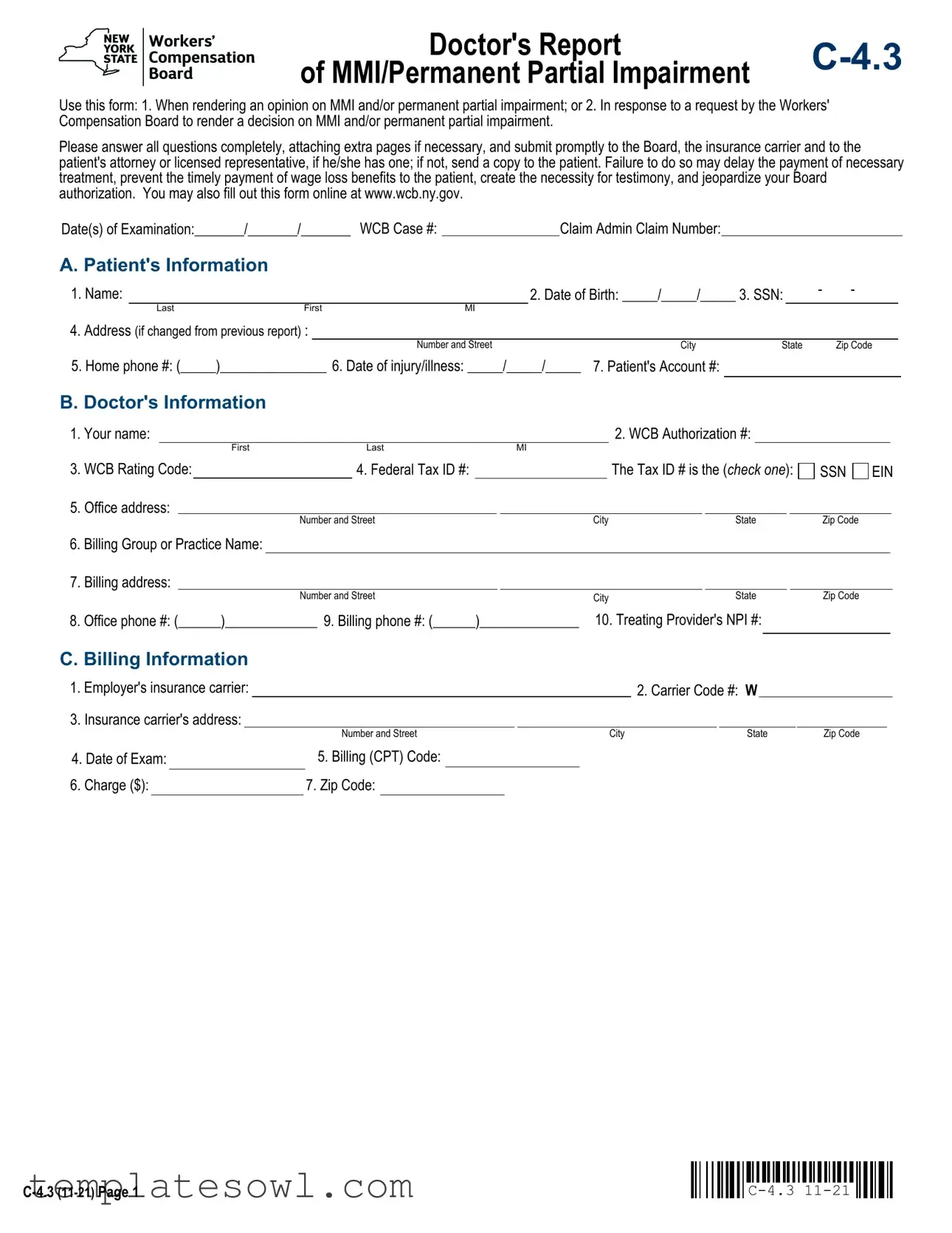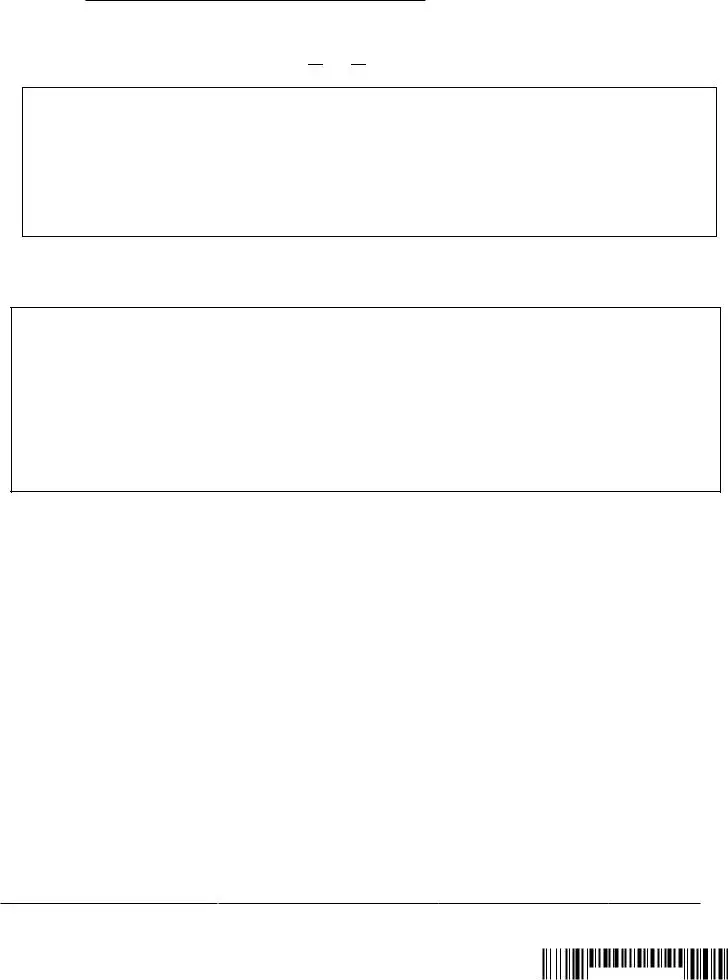
Doctor's Report |
C-4.3 |
of MMI/Permanent Partial Impairment |
Use this form: 1. When rendering an opinion on MMI and/or permanent partial impairment; or 2. In response to a request by the Workers' Compensation Board to render a decision on MMI and/or permanent partial impairment.
Please answer all questions completely, attaching extra pages if necessary, and submit promptly to the Board, the insurance carrier and to the patient's attorney or licensed representative, if he/she has one; if not, send a copy to the patient. Failure to do so may delay the payment of necessary treatment, prevent the timely payment of wage loss benefits to the patient, create the necessity for testimony, and jeopardize your Board authorization. You may also fill out this form online at www.wcb.ny.gov.
Date(s) of Examination:_______/_______/_______ WCB Case #:Claim Admin Claim Number:
A. Patient's Information
1. Name: |
|
|
|
2. Date of Birth: _____/_____/_____ 3. SSN: |
- |
- |
|
|
Last |
First |
MI |
|
|
|
|
|
|
|
4. Address (if changed from previous report) : |
|
|
|
|
|
|
|
|
|
|
|
|
Number and Street |
City |
State |
|
Zip Code |
|
5. Home phone #: (_____)_______________ 6. Date of injury/illness: _____/_____/_____ |
7. Patient's Account #: |
|
|
|
|
|
B. Doctor's Information
1. Your name: |
|
|
|
|
|
|
|
|
|
|
|
|
|
2. WCB Authorization #: |
|
|
|
|
|
|
|
|
|
|
First |
|
|
Last |
|
|
|
MI |
|
|
|
|
|
|
|
|
|
|
|
|
|
|
|
|
|
|
|
|
|
3. |
WCB Rating Code: |
|
|
|
4. Federal Tax ID #: |
|
|
|
|
|
|
|
|
The Tax ID # is the (check one): |
SSN |
EIN |
5. |
Office address: |
|
|
|
|
|
|
|
|
|
|
|
|
|
|
|
|
|
|
|
|
|
|
|
|
|
|
|
|
|
|
|
|
|
|
|
|
|
|
|
|
|
Number and Street |
|
|
|
|
|
City |
|
|
|
|
|
State |
|
|
|
|
|
Zip Code |
|
|
|
6. |
Billing Group or Practice Name: |
|
|
|
|
|
|
|
|
|
|
|
|
|
|
|
|
|
|
|
|
|
|
|
|
|
|
|
|
|
|
|
|
7. |
Billing address: |
|
|
|
|
|
|
|
|
|
|
|
|
|
|
|
|
|
|
|
|
|
|
|
|
|
|
|
|
|
|
|
|
|
|
|
|
|
|
|
|
|
Number and Street |
|
|
|
|
|
City |
|
|
|
|
|
State |
|
|
|
Zip Code |
|
|
|
8. |
Office phone #: (______)_____________ 9. Billing phone #: (______)______________ |
10. Treating Provider's NPI #: |
|
|
|
|
C. Billing Information |
|
|
|
|
|
|
|
|
|
|
|
|
|
|
|
|
|
|
|
|
|
|
|
|
|
|
|
|
|
|
|
|
|
|
|
|
|
|
|
|
|
|
|
|
|
|
|
|
|
|
|
|
|
|
|
|
|
|
|
|
|
|
|
|
1. |
Employer's insurance carrier: |
|
|
|
|
|
|
|
|
|
|
|
|
|
|
|
2. Carrier Code #: W |
|
|
|
|
|
3. |
Insurance carrier's address: |
|
|
|
|
|
|
|
|
|
|
|
|
|
|
|
|
|
|
|
|
|
|
|
|
|
|
|
|
|
|
|
|
|
|
|
|
|
|
|
|
|
|
Number and Street |
|
|
|
|
|
|
|
City |
|
|
|
|
|
State |
|
Zip Code |
|
|
|
4. Date of Exam: |
|
5. Billing (CPT) Code: |
|
|
|
|
|
|
|
|
|
|
|
|
|
|
|
|
|
|
|
|
|
|
|
|
|
|
|
|
|
|
|
|
|
|
|
|
|
|
|
|
|
|
|
|
|
|
|
|
|
|
|
|
|
|
|
|
|
|
|
|
|
|
|
|
|
|
|
6. |
Charge ($): |
|
|
7. Zip Code: |
|
|
|
|
|
|
|
|
|
|
|
|
|
|
|
|
|
|
|
|
|
|
|
|
|
|
|
C-4.3 (11-21) Page 1 |
C-4.3 11-21 |
Date of injury/onset of illness:______/______/______
D. Maximum Medical Improvement
1. Has the patient reached Maximum Medical Improvement?  Yes
Yes  No If yes, provide the date patient reached MMI: _____/_____/_____
No If yes, provide the date patient reached MMI: _____/_____/_____
If No, describe why the patient has not reached MMI and the proposed treatment plan (attach additional documentation, if necessary).
E. Permanent Partial Impairment
1.Is there permanent partial impairment?  Yes
Yes  No
No
2.List the body parts and conditions you treated the patient for related to the date of injury listed in Section A, Question 6.
Complete Permanent Partial Disability, Attachment A and/or Attachment B, as indicated based on the patient's condition. Attachment A and/or Attachment B must be completed for each body part and/or condition which you treated the patient for on the date of injury listed in Section A, Question 6.
nFor a permanent partial impairment where schedule award (schedule loss of use) is appropriate, complete Attachment A, except for serious facial disfigurement, vision, or hearing loss.
Hearing Loss:
lOccupational Loss of Hearing - C-72.1 should be utilized, and/or
lTraumatic Hearing Loss - C4.3 with an attached narrative.
Vision Loss:
lAttending Ophthalmologist's Report (Form C-5), or
lC-4.3 with an attached narrative.
Serious Facial Disfigurement
lC-4.3 with an attached narrative.
nFor a non-schedule award (classification), complete Attachment B.
Sign below and submit to the Board only the pages of the form that apply to this report.
This form is signed under penalty of perjury.
Board Authorized Health Care Provider signature:
|
|
/ |
/ |
Name |
Signature |
Specialty |
Date |
C-4.3 (11-21) Page 2 |
|
C-4.3 11-21 |
Date of injury/onset of illness:______/______/______
Permanent Partial Disability - Attachment B
Non-Schedule Award (Classification)
1. Non-Schedule Permanent Partial Disability:
(Identify impairment class according to the latest Workers' Compensation Guidelines for Determining Impairment. Attach separate sheet for |
additional body parts.) |
|
|
|
|
|
Body Part: |
|
Impairment Table: |
|
Severity Ranking: |
|
|
Body Part: |
|
Impairment Table: |
|
Severity Ranking: |
|
|
Body Part: |
Impairment Table: |
|
Severity Ranking: |
State the basis for the impairment classification (attach additional narrative, if necessary):
History:
Physical Findings:
Diagnostic Test Results:
2. Patient's Work Status: |
At the pre-injury job |
At other employment |
Not working |
3.Functional Capabilities/Exertion Abilities:
a. Please describe patient's residual functional capacities for any work at this time (not limited to the at-injury job activities):
|
Never |
Occasionally |
Frequently |
Constantly |
|
|
|
Lifting/carrying |
|
|
|
|
|
|
lbs. |
|
|
|
lbs. |
|
|
|
lbs. |
|
|
|
|
|
|
|
|
|
|
Pulling/pushing |
|
|
|
|
|
|
lbs. |
|
|
|
lbs. |
|
|
|
lbs. |
|
|
|
|
|
|
|
|
|
|
Sitting |
|
|
|
|
|
|
|
|
|
|
|
|
|
|
|
|
|
|
|
|
|
|
|
|
|
|
|
|
|
|
|
|
Patient's Residual Functional Capacities |
|
Standing |
|
|
|
|
|
|
|
|
|
|
|
|
|
|
|
n Occasionally: can perform activity up to |
|
|
|
|
|
|
|
|
|
|
|
|
|
|
|
|
|
|
|
|
|
|
|
|
|
|
|
|
|
|
|
|
|
|
|
|
|
|
|
|
|
|
|
|
|
|
1/3 of the time. |
|
Walking |
|
|
|
|
|
|
|
|
|
|
|
|
|
|
|
|
|
|
|
|
|
|
|
|
|
|
|
|
|
|
|
n Frequently: can perform activity from |
|
|
|
|
|
|
|
|
|
|
|
|
|
|
|
Climbing |
|
|
|
|
|
|
|
|
|
|
|
|
|
|
|
1/3 to 2/3 of the time. |
|
|
|
|
|
|
|
|
|
|
|
|
|
|
|
Kneeling |
|
|
|
|
|
|
|
|
|
|
|
|
|
|
|
n Constantly: can perform activity more |
|
|
|
|
|
|
|
|
|
|
|
|
|
|
|
|
|
|
|
|
|
|
|
|
|
|
|
|
|
|
|
|
|
|
|
|
|
|
|
|
|
|
|
|
|
|
than 2/3 of the time. |
|
Bending/stooping/squatting |
|
|
|
|
|
|
|
|
|
|
|
|
|
|
|
|
|
|
|
|
|
|
|
|
|
|
|
|
|
|
|
|
|
Simple grasping |
|
|
|
|
|
|
|
|
|
|
|
|
|
|
|
|
|
|
|
|
|
|
|
|
|
|
|
|
|
|
|
|
|
Fine manipulation |
|
|
|
|
|
|
|
|
|
|
|
|
|
|
|
|
|
|
|
|
|
|
|
|
|
|
|
|
|
|
|
|
|
Reaching overhead |
|
|
|
|
|
|
|
|
|
|
|
|
|
|
|
|
|
|
|
|
|
|
|
|
|
|
|
|
|
|
|
|
|
Reaching at/or below shoulder level |
|
|
|
|
|
|
|
|
|
|
|
|
|
|
|
|
|
|
|
|
|
|
|
|
|
|
|
|
|
|
|
|
|
Driving a vehicle |
|
|
|
|
|
|
|
|
|
|
|
|
|
|
|
|
|
|
|
|
|
|
|
|
|
|
|
|
|
|
|
|
|
Operating machinery |
|
|
|
|
|
|
|
|
|
|
|
|
|
|
|
|
|
|
|
|
|
|
|
|
|
|
|
|
|
|
|
|
|
Temp extremes/high humidity |
|
|
|
|
|
|
|
|
|
|
|
|
|
|
|
|
|
|
|
|
|
|
|
|
|
|
|
|
|
|
|
|
|
Environmental |
|
|
|
|
|
|
|
|
|
|
|
|
|
|
|
|
|
|
|
|
|
|
|
|
|
|
|
|
|
|
|
|
|
|
Specify: |
|
|
|
|
|
|
|
|
|
|
|
|
|
|
|
|
|
|
Psychiatric/neuro-behavioral (attach documentation describing functional limitations) |
|
|
|
b. Please check the applicable category for the patient's exertional ability: |
|
|
|
|
|
|
|
Very Heavy Work - Exerting in excess of 100 pounds of force occasionally, and/or in excess of 50 pounds of force frequently, and/or in excess of 20 pounds of force constantly to move objects. Physical demand requirements are in excess of those for Heavy Work.
Heavy Work - Exerting 50 to 100 pounds of force occasionally, and/or 25 to 50 pounds of force frequently, and/or 10 to 20 pounds of force constantly to move objects. Physical demand requirements are in excess of those for Medium Work.
Medium Work - Exerting 20 to 50 pounds of force occasionally, and/or 10 to 25 pounds of force frequently, and/or greater than negligible up to 10 pounds of force constantly to move objects. Physical demand requirements are in excess of those for Light Work.
Light Work - Exerting up to 20 pounds of force occasionally, and/or up to 10 pounds of force frequently and/or negligible amount of force constantly to move objects. Physical demand requirements are in excess of those for Sedentary Work. Even though the weight lifted may only be a negligible amount, a job should be rated Light Work: (1) when it requires walking or standing to a significant degree; or (2) when it requires sitting most of the time but entails pushing and/or pulling of arm or leg controls; and/or (3) when the job requires working at a production rate pace entailing the constant pushing and/or pulling of materials even though the weight of those materials is negligible. NOTE: The constant stress of maintaining a production rate pace, especially in an industrial setting, can be and is physically demanding of a worker even though the amount of force exerted is negligible.
Sedentary Work - Exerting up to 10 pounds of force occasionally and/or a negligible amount of force frequently to lift, carry, push, pull or otherwise move objects, including the human body. Sedentary work involves sitting most of the time, but may involve walking or standing for brief periods of time. Jobs are sedentary if walking and standing are required only occasionally and all other sedentary criteria are met.
C-4.3B (11-21) Page 4 |
C-4.3 11-21 |
IMPORTANT - TO THE ATTENDING DOCTOR
The C-4.3 has been modified to accommodate the 2018 Workers' Compensation Guidelines for Determining Impairment, while continuing to reflect the 2012 Guidelines for Determining Permanent Impairment and Loss of Wage Earning Capacity. The 2018 Guidelines replace chapters in the existing 2012 Medical Impairment Guidelines Introduction and with respect to SLU. The 2012 Guidelines should continue to be used for determining non-schedule permanent impairments. This form is to be used to file reports in workers' compensation, volunteer firefighters' or volunteer ambulance workers' benefits cases as follows: 1. When rendering an opinion on MMI and/or permanent partial impairment; or 2. In response to a request by the Workers' Compensation Board to render a decision on MMI and/or permanent partial impairment.
MEDICAL REPORTING
This form must be signed by the attending doctor and must contain his/her authorization certificate number, code letters and NPI number.
A CHIROPRACTOR, PODIATRIST, PSYCHOLOGIST, NURSE PRACTITIONER OR LICENSED CLINICAL SOCIAL WORKER FILING THIS REPORT CERTIFIES THAT THE INJURY DESCRIBED CONSISTS SOLELY OF A CONDITION(S) WHICH MAY LAWFULLY BE TREATED BY THE FILING PROVIDER, AS DEFINED IN THE EDUCATION LAW AND, WHERE IT DOES NOT, THE FILING PROVIDER HAS ADVISED THE INJURED PERSON TO CONSULT A PHYSICIAN OF HIS/HER CHOICE.
HIPAA NOTICE - In order to adjudicate a workers' compensation claim, WCL13-a(4)(a) and 12 NYCRR 325-1.3 require health care providers to regularly file medical reports of treatment with the Board and the insurer or employer. Pursuant to 45 CFR 164.512 these legally required medical reports are exempt from HIPAA's restrictions on disclosure of health information.
Ask the patient if he/she has retained a legal representative. If they have retained legal representation, you are required to send copies of all reports to the patient's representative.
Instructions for Completing Section D, E, Attachment A and Attachment B
Section D. Maximum Medical Improvement
Section D includes questions regarding maximum medical improvement (MMI). For the definition of MMI, see Chapter 1.2 of the 2018 Guidelines and 2012 Guidelines. A provider who finds that the patient has met MMI should so indicate and provide the approximate date of such finding (Question 1). If the patient has not yet reached MMI so indicate (Question 1) and provide an explanation as to why additional improvement is expected and the proposed treatment plan.
Section E. Permanent Partial Impairment
Section E includes questions regarding permanent partial impairment. If there is no permanent partial impairment (Question 1) do not file this form, instead use Form C-4.2 (Dr's. Progress Report), unless requested by the Workers' Compensation Board to render a decision on MMI and/or permanent partial impairment. For more information on evaluating impairment, see Chapter 1.5 and 1.6 of the 2018 Guidelines and Chapter 9.2 of the 2012 Guidelines.
List all the body parts and/or conditions that the patient was treated for with regards to the workers' compensation claims identified in Section A of the form (Question 2). Complete either Attachment A and/or Attachment B for each body part and/or condition for which permanency exists.
Permanent Partial Disability
Attachment A and Attachment B includes questions about schedule loss of use of member or facial disfigurement (1) or Non-Schedule Permanent Partial Impairment (2). Complete Attachment A and/or Attachment B for each body part and condition for which the patient was treated. If the patient injured body parts that receive a schedule and do not receive a schedule, then complete both Attachment A and Attachment B for the appropriate body parts/conditions.
Attachment A. Schedule loss of use of member
Determine impairment % using the 2018 Workers' Compensation Guidelines for Determining Impairment. If a scheduled loss is appropriate under the 2018 Impairment Guidelines do not complete any questions in Attachment B. Attach additional sheets or narrative, if necessary. The provider should sign the Board Authorization at the bottom of page 2 and return to the Workers' Compensation Board.
Attachment B. Non-Schedule Permanent Partial Impairment
If the patient was treated for a body part and condition that is not amendable to a schedule loss of use award, record the body part, impairment table and severity letter grade for each body part or system (Question 1) using the 2012 Guidelines. Also state the history, physical findings, and diagnostic test results that support the impairment finding. If the patient has a non-schedule impairment of a body part or system that is not covered by an impairment guideline, follow Chapter 17 of the 2012 Guidelines and include the relevant history, physical findings, and diagnostic test results, but no severity letter grade.
Complete the questions regarding the patient's work status (2).
Complete the Functional Capabilities/Exertion Abilities (Question 3. a - f). Attachment B should be completed based on the patient's current condition if the provider believes there is MMI and/or permanent partial impairment or in a response to a request by the Board to render a decision on MMI and/or permanent partial impairment.
Question 3. includes questions applicable to a patient who has reached MMI and has a permanent, non-schedule impairment. For more information on evaluating functional capabilities, see Chapter 9.2 of the 2012 Guidelines. Measure and record the specific functional abilities and losses caused by the work-related medical impairment on Questions 3, a through f as follows:
Question 3a - Rate whether the patient can perform each of the fifteen functional abilities: never, occasionally, frequently, or constantly. Note the specific weight tolerances for the categories lifting/carrying and pulling/pushing. There is also room to describe any functional limitations in connection with environmental conditions (e.g., occupational asthma). Attach documentation when describing Psychiatric/neuro-behavioral functional limitations, if applicable to a patient.
Question 3b - Check the applicable category for the patient's exertional ability.
Question 3c - Note any other medical considerations arising from the permanent injury that are not captured elsewhere in Attachment B. This includes any restrictions or limitations that may be imposed as a result of medications (e.g., narcotics) taken by the patient or other relevant medical considerations that impact work function.
Question 3d - With knowledge of the patient's at-injury work activities, indicate whether the patient can perform his/her at-injury work activities with restrictions. If Yes, specifically assess the patient's ability to perform his/her at-injury work activities with restrictions.
Question 3e. Indicate whether the patient can perform any work activities with or without restrictions. Explain by providing what activities can be performed with restrictions and what work activities can be performed without restrictions.
Question 3f - Provide an explanation whether reasonable accommodations can be made for the patient.
Question 4 - Explain or attach a detailed explanation if the patient has had an intervening injury or illness that may account for any of the functional restrictions noted in Question 3a.
Question 5 - Indicate if the patient would benefit from vocational rehabilitation and if so, provide detailed explanation.
C-4.3 (11-21) INSTRUCTIONS

BILLING INFORMATION
Complete all billing information contained on this form. Use additional forms or narrative, if necessary. The workers' compensation carrier has 45 days to pay the bill or to file an objection to it. Contact the workers' compensation carrier if neither payment nor an objection are received within this time period. After contacting the carrier, if necessary, file Health Provider's Request for Decision on Unpaid Medical Bill(s) (Form HP-1). If you have questions, please contact the NYS Workers' Compensation Board at 1-800-781-2362.
ANY PERSON WHO KNOWINGLY AND WITH INTENT TO DEFRAUD PRESENTS, CAUSES TO BE PRESENTED, OR PREPARES WITH KNOWLEDGE OR BELIEF THAT IT WILL BE PRESENTED TO OR BY AN INSURER, OR SELF-INSURER, ANY INFORMATION CONTAINING ANY FALSE MATERIAL STATEMENT OR CONCEALS ANY MATERIAL FACT SHALL BE GUILTY OF A CRIME AND SUBJECT TO SUBSTANTIAL FINES AND IMPRISONMENT.
All reports are to be filed by sending directly to the Workers' Compensation Board at the address below with a copy sent to the insurance carrier:
NYS Workers' Compensation Board - Centralized Mailing, PO Box 5205, Binghamton, NY 13902-5205
C-4.3 (11-21) INSTRUCTIONS



 Yes
Yes  No If yes, provide the date patient reached MMI: _____/_____/_____
No If yes, provide the date patient reached MMI: _____/_____/_____ Yes
Yes  No
No
 C-4.3
C-4.3

